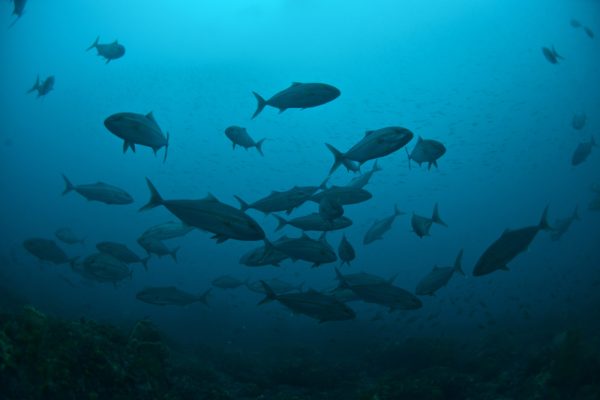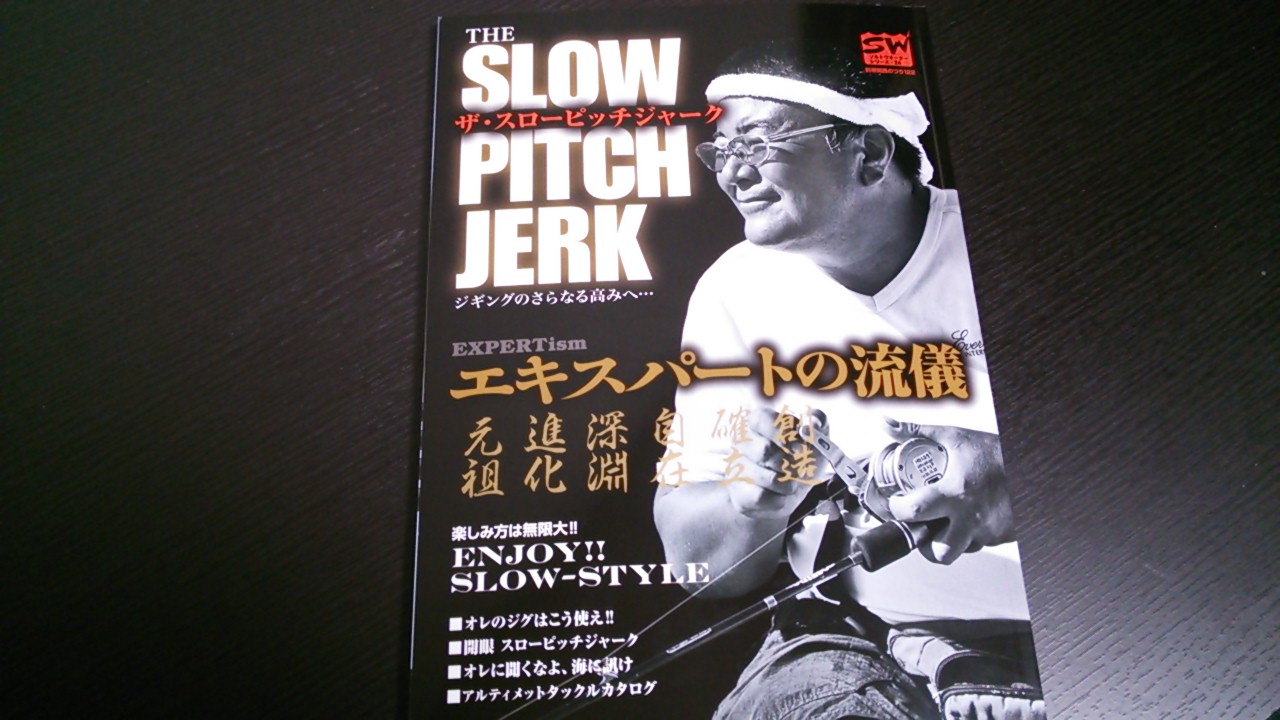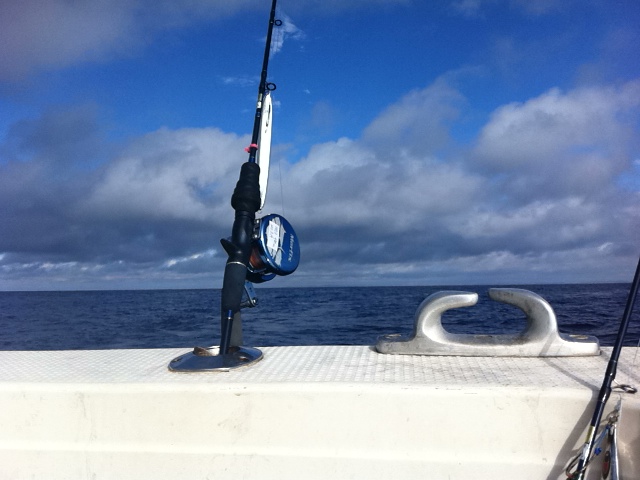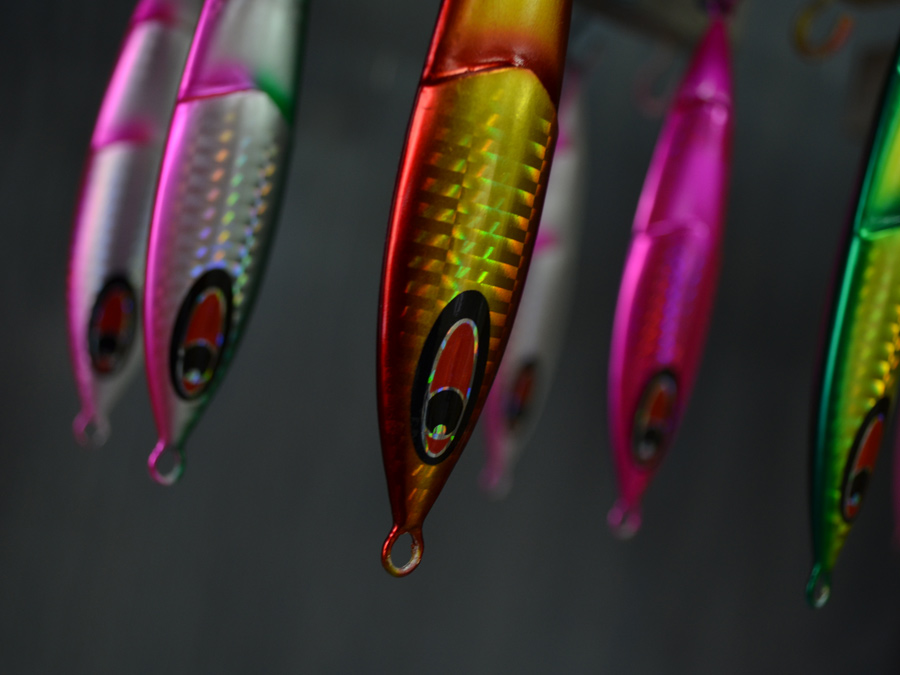What we want to know about fish
The Slow Pitch Jerk, Kansai no Tsuri, Salt Water Series vol.24
Out of our slow pitch jigging bible, I’d like to share some interesting articles by Sato Sensei about fish sensory system.

Auditory Sense
Fish has the auditory sensor system all along their body. They are indeed “all ears.” It’s considered that fish hunt mainly by the sound waves.
Human audible range is from 20Hz to 20,000Hz, while fish is about from 20Hz to 2000Hz. It’s limited to low-pitched sound.
What we need to consider about the sound is the line. Jiggers actively move the line to fish and it must be creating a lot of sound waves in the water. The heavier line is stronger. And lighter line gets more contacts. This is a fact that we all face. When I used to do jigging with a heavy leader, Sato Sensei pointed out to me that it is like fishing with a 5 meter jig.
Fish is probably not hearing the metal clicking at the rings and the hooks.
On the other hand, it’s considered to be very effective to knock the bottom to make a sound. Making a little commotion of something feeding on something always attract other fish-eaters.
From my experience as a free diver, I totally agree that fish live in the world of sound. Sound travels in the water much faster and further than in the air, while light doesn’t travel well in the water. There’s no reason for fish to depend on eye sight like we human depend 90% on it. That’s exactly the reason why dolphins, once eye-sight dependent land animal, have developed the highly sophisticated auditory sensory system called echo-location to adapt to the underwater environment.
When they see your jig, yur target fish should be at the verge of one way to predation and the other way to cautiousness. Which way it rolls to? It may be like a roll of a dice. But we sure want to present our jig with as little caution factors as possible.
Sudden impact to the line moves the line to slash through the water and make sound waves. So I’m convinced that it’s so important to pick up the jig softly after each falls and connect every actions to flow. Slow pitch jigging is so effective because it gives so much time to the jig to swim on its own.
Visual Sense
Fish has very poor eye-sight. They don’t see the shape well, but they are very keen to movements. For them, time to eat and time to be eaten happen at the same time.
Sato Sensei points out fish avoid anything moves toward them. Like we do. We back off to a tiny fly if it moves toward us. Also they chase after anything runs away from them.
Sato Sensei also points out that when they attack a school of fish, they target ones that are not swimming well or swimming differently.
Our focus is on funny but natural movements. That is why we want to let the jig swim on its own and try to have that hangtime as long and as many as possible.
Anatomy shows that off-shore fish has more vision sensors for contrast, while some coastal fish has more vision sensors for colors. For jigging targets, contrast is more important, and the movement is far more important because movements make sounds that the fish is keen to.
Conception of time
The kind of movements fish are looking for in their bait fish are:
A. Disoriented or crippled, twirling motions
B. Tore away from the school, panicking motions
C. Knocked unconscious, suspending motions
C is the most favorable baits of all. I think this is the main focus Sato Sensei created this method on, to get continuous small horizontal movements, rather than rapid vertical movements.
It is considered that fish conception of time is 55 times faster than humans. Meaning that they see everything in slow motion x55. 1 second of flash movement for us is like a 1-minute slow motion. This is how they perceive the fast moving object precisely.
On the other hand, a slow moving object should look like it’s suspending in the water. Slow pitch jigging takes advantage of fish conception conversely.
This was a big break through for me. Every movements are slow motions to fish!!! Wow… I don’t know how I can take this knowledge into my tactics, but it’s good to know. Maybe I should perform the change of pace more drastically.
Hope the information helps you! Good luck!
Related Posts
10 Comments
Leave a Reply Cancel reply
Categories
- 1. SPJ (57)
- 1-1. Principles (9)
- 1-2. Techniques (11)
- 1-3. Setup (17)
- 1-4. FAQ (19)
- 1-5. Tackles (3)
- 1-6. Video Gallery (2)
- 2. Other Offshore Games (5)
- 3. Fishing Report (105)
- 3-1. Totos (25)
- 3-2. Readers (72)
- 4. Fish Cooking (19)
- 4-1. Iki-Jime (3)
- 4-2. The Art of Sashimi (5)
- 4-3. Recipe (7)
- 4-4. Seasoning (3)
- 5. Fishing Charter (6)
- Fish (12)






very true!
thks so much for translating this for all of us Totos!
However this is the bit i am still abit ”skeptical” about?
”Sato Sensei points out fish avoid anything moves toward them.”
Sato Sensei is definitely not wrong but, hmm then if this is the case, where or rather how do long fall jerks come into play then? also many fish hit on the drop? so how does this fit in?
also, say take for example a very successful technique that u have taught me Totos:
-when the jig hits the bottom, take 3-5 moderate to fast continuous cranks, followed by two or one slow pitch lifts.
as the jig hits the bottom, you have already garnered fish interest, and say they are chasing your jig up along the way as u make your 3-5 continuous fast cranks, by taking two slow pitches, arent u creating that hang time and slack to allow your jig to fall back, and isint that more often than not your strike trigger?
so is Sato Sensei saying that when we do our slow pitches we shld not allow too much hang time for the jig to drop down, but rather just long enough to momentarily suspend n get horizontal with the water column?
hahaha slow pitch is so technical. but i guess its part of the fun eh!
ohh and could i also have Sato Sensei’s full name, his name always shows up different on google translate :/
daniel maybe it works because the fish is not directly below the jig when it is chasing it up is out to the side of it more plus when the jig is dropping it goes horizontal away from it now I am confused ha
Hi Daniel.
As Carl pointed out, unless you are hitting the fish in the head at the bottom, the fish won’t be making the bite from directly below.
But I know how you feel skeptical. I understand what Sensei says but because I don’t know how to take it into my practice, I feel frustrated.
But it’s not just Sato Sensei (his name is Norihiro Sato) but other leading anglers say this too and they each have techniques to avoid scaring fish.
With some jigs, use a technique to “suspend” the jig after the lift and before the fall.
Some jigs falls backwards. With these jigs, use the technique to slide more to the side, not to the bottom in the direction that the fish might be charging from.
With some jigs, give a strong impact on uplift, and “knock” the line once and release again to fall. This “knock” flips the jig when it is sliding to the side. When flipped, the jig falls backwards to the same direction it was heading.
They showed me techniques like this. (Sorry, yet, I’m doing my best to describe in words). I’m still learning. And I have to admit I am skeptical if these techniques make differences at all. I know I’ll be confident only when I see it works with my hands.
The top anglers are doing these tricks just in the effort to reduce risks. You can get contacts with or without. I think we are not looking for an easy way to fish here. We want more. We all love the feeling of “YOU hit the fish. Not the FISH hit you.”
Hi Totos
If the fish see things that much slower that’s when attention to detail really comes into its own. I think if that’s true then fish will be able to notice when we aren’t fluent enough with our movements even easier. I notice that I get bites on the drop a lot, that means that I have not put any influence on the jig at all and it is just fluttering to the bottom with a steady pattern looking injured. I’m always worried about scaring the fish rather than enticing them.
Hi Mark. All true. Yes, that’s exactly what these top anglers are talking about. Try to get the time in which the jig swims or falls on its own as much as possible without human influence. The top slow pitch jig makers like Seafloor Control and Deepliner are actually designing the jig in the way it doesn’t act too much. If it acts too much, it may turn around at the end of sliding and face toward the charging fish. Slow pitch jiggers don’t like flamboyant jigs as we don’t like to give warnings to the fish.
greeting from greece. what you can do when you see a big pack of snappers on the screen of yor fishfinder who are dissapearing imediately when they see your jig just falling on them from the first time? i am talking for places that have many visits frome many anglers. fot fishes tha maybe know the names of the fisherman above them.
Hi Yiannis.
Yea, it’s possible that the fish know who you are 🙂
It’s possible the fish is so familiar with jigs and fleet away at the drop.
But the professional captains should disagree that anyone could tell that’s what really happened by looking at the fishfinder. It’s most likely that you simply drifted away from where the fish is.
It involves a lot of imagination, based on a good knowledge of how the current is running and how your boat is influenced by the wind, to fill in the blank of what the screen is not showing. It’s rather impossible to stay directly over the fish for 10 seconds in most situations.
Thanks for the answer, but i belive thats not my case. I am talking about just 40 mettres of water (pretty shallow) and most of the times i can see my jig on the screen and also the fishes going down (means that they are seeing me and simply sweeming away) I am talking about a pack of big snappers (pagrus) that they are staying at the same spot about one month every julie (thay are here now). I only manage to take 4 or 5 fishes every year from that pack, between 5 to 8 kilos (in 5 or 6 exits to tthe sea). Is there something in your opinion that i can do to catch more of them? Thanks again !
If you are sure that the fish is fleeting away from your jig and you still manage to catch 4 or 5 fish out of the pack every year, that’s considerably good! Wouldn’t you say?
But slow pitch is there for the anglers like yourself with ever lasting desire to catch more.
However, there’s no secrets that work every time. We are in search for all the successful patterns that work sometimes, not for one mighty solution that work every time. Because there’s none. Every experts agree that fish tendency changes everyday, every hour, every tide. You just need to keep changing until you hit.
What can you change?
Your actions, focus on the lift or the fall, rods, jig weights, jig types… There a whole lot of combinations that slow pitch can offer.
But it’s also very important to leave it alone for a while. Every hot spots need rest. Like Yin and Yang. You need a time of Yin to get a time of Yang.
Especially for the ones who stay in one place. We have several hot spots that we call “grouper condo”. We hit the spot only once or twice at a time.
Thank you very much Totos! We agree 100% .